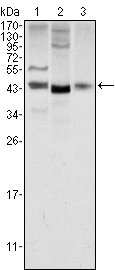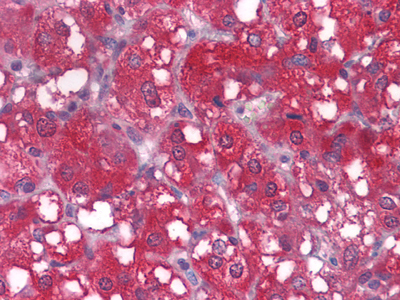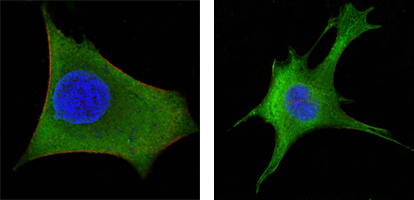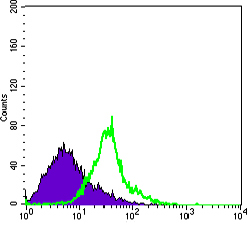Wnt-1 Monoclonal Antibody
- Catalog No.:YM0649
- Applications:WB;IHC;IF;FCM;ELISA
- Reactivity:Human;Mouse
- Target:
- Wnt-1
- Fields:
- >>mTOR signaling pathway;>>Wnt signaling pathway;>>Hippo signaling pathway;>>Signaling pathways regulating pluripotency of stem cells;>>Melanogenesis;>>Cushing syndrome;>>Alzheimer disease;>>Pathways of neurodegeneration - multiple diseases;>>Human papillomavirus infection;>>Pathways in cancer;>>Proteoglycans in cancer;>>Chemical carcinogenesis - receptor activation;>>Basal cell carcinoma;>>Breast cancer;>>Hepatocellular carcinoma;>>Gastric cancer
- Gene Name:
- WNT1
- Protein Name:
- Proto-oncogene Wnt-1
- Human Gene Id:
- 7471
- Human Swiss Prot No:
- P04628
- Mouse Gene Id:
- 22408
- Mouse Swiss Prot No:
- P04426
- Immunogen:
- Purified recombinant fragment of Wnt-1 expressed in E. Coli.
- Specificity:
- Wnt-1 Monoclonal Antibody detects endogenous levels of Wnt-1 protein.
- Formulation:
- Liquid in PBS containing 50% glycerol, 0.5% BSA and 0.02% sodium azide.
- Source:
- Monoclonal, Mouse
- Dilution:
- WB 1:500 - 1:2000. IHC 1:200 - 1:1000. IF 1:200 - 1:1000. Flow cytometry: 1:200 - 1:400. ELISA: 1:10000. Not yet tested in other applications.
- Purification:
- Affinity purification
- Storage Stability:
- -15°C to -25°C/1 year(Do not lower than -25°C)
- Other Name:
- WNT1;INT1;Proto-oncogene Wnt-1;Proto-oncogene Int-1 homolog
- Molecular Weight(Da):
- 41kD
- References:
- 1. Blood. 2008 Jan 1;111(1):122-31.
2. BMC Cancer. 2005 May 24;5:53.
- Background:
- The WNT gene family consists of structurally related genes which encode secreted signaling proteins. These proteins have been implicated in oncogenesis and in several developmental processes, including regulation of cell fate and patterning during embryogenesis. This gene is a member of the WNT gene family. It is very conserved in evolution, and the protein encoded by this gene is known to be 98% identical to the mouse Wnt1 protein at the amino acid level. The studies in mouse indicate that the Wnt1 protein functions in the induction of the mesencephalon and cerebellum. This gene was originally considered as a candidate gene for Joubert syndrome, an autosomal recessive disorder with cerebellar hypoplasia as a leading feature. However, further studies suggested that the gene mutations might not have a significant role in Joubert syndrome. This gene is clustered with another family member, WNT10B, in
- Function:
- function:Ligand for members of the frizzled family of seven transmembrane receptors. Probable developmental protein. May be a signaling molecule important in CNS development. Is likely to signal over only few cell diameters.,similarity:Belongs to the Wnt family.,subunit:Interacts with PORCN. Interacts with RSPO1, RSPO2 and RSPO3.,
- Subcellular Location:
- Secreted, extracellular space, extracellular matrix . Secreted .
- Expression:
- Testis,
CPNE1 silencing inhibits the proliferation, invasion and migration of human osteosarcoma cells. ONCOLOGY REPORTS 2017 Dec 04 WB Human 1:1000 Saos-2 cell
- June 19-2018
- WESTERN IMMUNOBLOTTING PROTOCOL
- June 19-2018
- IMMUNOHISTOCHEMISTRY-PARAFFIN PROTOCOL
- June 19-2018
- IMMUNOFLUORESCENCE PROTOCOL
- September 08-2020
- FLOW-CYTOMEYRT-PROTOCOL
- May 20-2022
- Cell-Based ELISA│解您多样本WB检测之困扰
- July 13-2018
- CELL-BASED-ELISA-PROTOCOL-FOR-ACETYL-PROTEIN
- July 13-2018
- CELL-BASED-ELISA-PROTOCOL-FOR-PHOSPHO-PROTEIN
- July 13-2018
- Antibody-FAQs
- Products Images

- Western Blot analysis using Wnt-1 Monoclonal Antibody against NIH/3T3 (1), 3T3L1 (2) and HeLa (3) cell lysate.

- Immunohistochemistry analysis of paraffin-embedded human LAdrenal tissues with AEC staining using Wnt-1 Monoclonal Antibody.

- Confocal immunofluorescence analysis of Hela (left) and 3T3-L1 (right) cells using Wnt-1 Monoclonal Antibody (green). Red: Actin filaments have been labeled with DY-554 phalloidin. Blue: DRAQ5 fluorescent DNA dye.

- Flow cytometric analysis of Hela cells using Wnt-1 Monoclonal Antibody (green) and negative control (purple).


